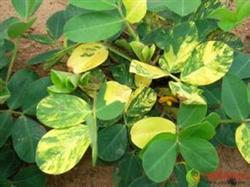How to prevent and cure peanut virus disease

Flower disease, one of the main diseases of peanut, seriously affects the yield and quality of peanut, especially in the northern production areas of our country. Peanut virus disease, except bud blight mainly transmitted by thrips, other diseases such as light mottle disease, yellow mosaic disease and common mosaic disease are transmitted by seeds and aphids. The seed transmission rate is mainly affected by the period of the disease, the disease is early and the seed transmission rate is high. The virus-carrying rate of seeds was negatively correlated with seed size. The virus-carrying rate of large seeds was low, while that of small seeds was high. In the presence of virus sources and susceptible varieties, the occurrence and number of aphids are the main factors for the prevalence of virus diseases. The aphids that transmit the virus are mainly winged aphids active in the field. In general, peanut aphids occur early and have a large number of aphids, which is easy to cause serious disease epidemic, otherwise the disease is mild. The peanut seedling stage has less rainfall, mild climate and dry climate, which can easily lead to the occurrence of aphids and the prevalence of diseases, and vice versa. Control methods: first, the use of non-toxic or low-toxic seeds to eliminate or reduce the source of primary infection. Non-toxic seeds can be obtained by isolation propagation. Second, Yuhua 1, Haihua 1, Yuhua 7 and other varieties with mild disease and low seed transmission rate were selected, and large kernel was selected as seed. The third is to popularize the plastic film mulching technology, which has a certain effect of expelling aphids and can reduce the harm of virus diseases. Fourth, timely removal of weeds in the field and around to reduce the source of aphids. Fifth, do a good job in disease quarantine and prohibit replanting from disease areas. Sixth, chemical control of aphids, sowing with 3% carbofuran granules to cover seeds, 2.5 kg-3 kg per mu, or 25% phoxim (812), 0.5 kg per mu, after peanut emergence, timely inspection, hairy aphids timely spraying with 40% dimethoate EC 800 times liquid, in order to put an end to aphid transmission.
- Prev

Double improvement of yield and quality in comprehensive prevention of peanut fruit rot
Peanut fruit rot is also known as "peanut rot disease". In recent years, the disease is more common in the main peanut producing areas in our province, such as Daming, Xinle, Dingzhou, Xingtang, Luan County and so on, especially when Rain Water is encountered in the podding period of continuous cropping for many years. The disease will be more serious. According to the survey, if the infected land is light, the yield will be reduced by 20%.
- Next

How to control peanut bacterial wilt
The period of peanut flowering and needle dropping is the outbreak period of peanut bacterial wilt, during this period, attention should be paid to spray control. Control method: when peanuts begin to show buds, spray 1500 times 70% carbendazim solution or 600 times 20% thiophanate copper solution on the leaves every 10 to 15 days, and spray all leaves evenly to begin to have water droplets.
Related
- The first cup of black tea in spring, the flavor and history of tea gardens in Kenya, Africa
- The computer can not only choose potatoes, but also grow tea rice. AI will grow winter oolong tea champion.
- It is not only the inflated tea bitten by insects, but also engraved with the four seasons tea in Beipu.
- The Oriental Beauty Tea Festival in Zhuxian County takes the stage at the weekend to experience the plus-size feast of oil tea.
- & quot; Oriental Beauty Tea & Exploration of Emei in Hsinchu, the hometown of quot;
- The new variety of strawberry "Tainong 1" dessert is the first choice with mellow aroma. Crimson gorgeous
- History of Tea in Taiwan: from Wild Inner Mountain to Export Tea Garden
- Two types of Taiwan Oriental Beauty Black Tea won the British three-Star Award for Childhood Tea Xiang Zhang Jiaqi changed from pilot to champion tea maker.
- Banana species and varieties: the planting history of Taiwan Xianren banana and dwarf banana is long, is banana disease resistant?
- Coffee planting Technology: Qianjie Coffee from Seedling to harvesting

